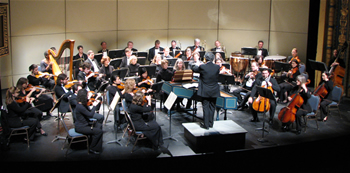The Greensboro Symphony Orchestra kicked off its 2013-14 Masterworks season (now funded in part by Tanger) with music devoted to dance. Members of the Greensboro Ballet joined the orchestra in several of the works.
The evening began, fittingly enough, with “Invitation to the Dance,” (1819) by Carl Maria von Weber. The work was originally written for piano, but Hector Berlioz orchestrated it in 1841. The opening cello solo (which returns at the conclusion of the piece) was finely played by Beth Vanderborgh. The languid line is answered by the winds in a short, conversational manner before the dance proper begins. The sectional (and repetitive) work is characterized by its colorful orchestration (thank you, Mr. Berlioz), and the animated proceedings provided for a good launchpad for the rest of the evening’s music.
More Berlioz followed: The “Hungarian March,” from the composer’s The Damnation of Faust. GSO Music Director Dmitry Sitkovetsky provided commentary throughout the evening, calling himself a “classical music DJ.” He explained that this march had nothing to do with the opera but was written to appease Hungarian audiences. A rousing brass fanfare introduces the march, which primarily resides in the winds with the strings providing pizzicato accompaniment. All-out brass wailing brings the work to a triumphant conclusion. All sections of the orchestra played with palpable enthusiasm.
The ballet folks joined the orchestra in “Danse Bacchanale” from Saint-Säens’ opera Samson and Delilah. Middle Eastern melodies intertwine with more European sounds to give the piece an exotic hue. The wild music, originally intended to be danced by priests, was performed by a male lead with three women.
Armenian Aram Khachaturian’s fanciful “Waltz” from the incidental music for the play Masquerade was followed by the composer’s most famous work, “Sabre Dance.” (Because the music is used so much on TV in cartoons and commercials, Sitkovetsky told members of the audience that “If you don’t know it, you haven’t lived here.”) The oft-heard work comes from his otherwise little-known ballet Gayane. Again, the GSO Ballet joined in with a dance that matched the raucous and rambunctious music.
Music by another Russian, Alexander Borodin, concluded the first half of the program. His “Polovtsian Dances” from his opera Prince Igor is chock full of great tunes, many used in the 1953 musical Kismet. All nine dancers were on stage for this: GSO Ballet members Dario Azarte, Nina Bass, Jacky Hauser, Breanne Horne, special guests Jeff Wolfe and Preston Swovelin, and Marci Laird, Ashley Presson, and Susannah Wares.
Borodin’s music goes from lush, lyrical melodies through majestic moods and whirlwind wildness. The choreography, which included thigh- and foot-slapping, captured the many moods.
Leonard Bernstein’s “Symphonic Dances” from West Side Story contains many (but certainly not all) of the legendary musical’s tunes. I swear there are not many pieces in the repertoire that are as boisterous and as loud as some of the passages in this piece, and the GSO played it full out. The many percussionists helped bring the score alive, and Sitkovetsky’s energetic conducting seemed to ignite the orchestra. Although the opening tempo seemed a bit relaxed to me, the fiery sections burned with energy. Quiet passages featured a solo string quartet, played by the first-chairs, A horn flub marred an otherwise lovely presentation of “There’s a Place for Us,” and the orchestra got to snap its fingers and shout “mambo” in the course of the work.
Maurice Ravel was enamored with the 19th century waltz, and in 1919-20, he wrote “La Valse” as a tribute to Johann Strauss, the Waltz King. Much of this work is dream-like, as if the music is somewhat obscured by a scrim; the result is a veiled passion. But other times the music erupts with force that is, well, quite un-waltz like. This final piece again featured elegant footwork (including the women on point) from all nine dancers. Unfortunately, the program failed to identify the choreographer.
The medium-sized crowd seemed to enjoy this union of dance and music; many hardy hoots and screams followed several of the sections with dance, as well as the more predictable final standing ovation.
This program will be repeated on October 5 at 2 p.m. (a shortened, intermission-less version) and at 8 p.m., in the same venue. For details, see the sidebar.












